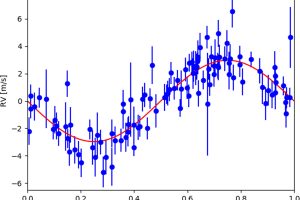A new super-Earth around a M star. The research: “The HADES RV programme with HARPS-N at TNG. XI. GJ 685 b: a warm super-Earth around an active M dwarf” led by M. Pinamonti (INAF-OATo) recently appeared on A&A

To date, more than 4000 exoplanets (planets orbiting around other stars) have been confirmed. These planets belong to different groups depending on their properties. Some of these families, such as gaseous giants or rocky planets, are present in our Solar System, while others, such as super-Earths and Hot Jupiters, are missing. Besides, there are strong indications that the properties of the central star are important to determine the type of planets present in their system. For instance, gaseous giants seem to be more frequent around high mass stars, while rocky planets are more common around low mass stars. For this reason, M stars have become typical targets for the search of super-Earths, e.g. rocky planets with a mass between 2 and 10 Earth masses). Besides, the two techniques typically used to discover exoplanets (radial velocity and transits) are particularly effective in finding planets around M stars for the more favourable contrast of mass and luminosity between star and planet in these systems.
This has motivated several programs aimed at finding exoplanets around M stars. Among these projects, the Harps-n red Dwarf Exoplanet Survey (HADES) is based on the collaboration between the Italian consortium Global Architecture of Planetary Systems (GAPS), the Institut de Ciències de l’Espai de Catalunya (ICE), and the Instituto de Astrofísica de Canarias (IAC). This project is aimed at finding exoplanets around stars with a spectral class between M0 and M3 with the method of the radial velocity. The project is based on observations acquired with the HARPS-N instrument, mounted on the Telescopio Nazionale Galileo.
The study “The HADES RV programme with HARPS-N at TNG. XI. GJ 685 b: a warm super-Earth around an active M dwarf” of the astronomer M. Pinamonti (INAF-Astronomical Observatory of Turin), recently appeared on Astronomy & Astrophysics, describes the discovery of a super-Earth around the M0 star GJ 685. The discovery has been possible thanks to a long series of 106 spectroscopic observations of this star obtained with HARPS-N. The team, counting also the astronomers J. Maldonado, G. Micela, A. Maggio and L. Affer of INAF-Astronomical Observatory of Palermo, has identified three periodic signals in the radial velocity series of this star. Two of them, with a period of 9 and 18 days, are due to the magnetic activity of GJ 685. The third one, with a period of 24 days, is instead due to a super-Earth with a mass of about 9 Earth masses, orbiting around the star each 24.16 days with a major semi-axis of 0.13 Astronomical Units (the mean Earth-Sun distance, equal to 150 million km).
The figure (link) shows the folded radial velocity signal due to GJ 685b.
by Mario Giuseppe Guarcello ( follow mguarce)
